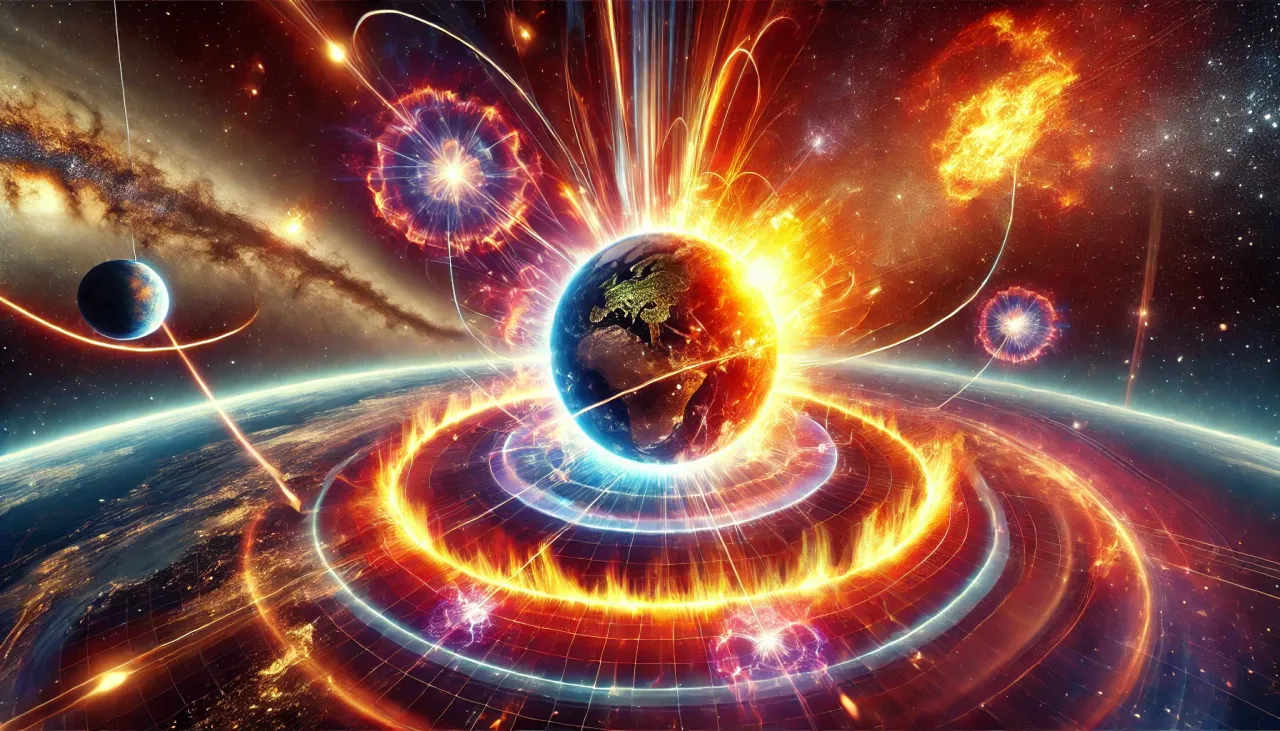
Space Radiation Environment
The space radiation environment consists of multiple particles from different sources. Depending on their origins, these particles exhibit various energy levels and fluxes in space. The energy of particles is typically measured in electronvolts (eV). To describe particle density and dynamics, the concept of flux is used, indicating how many particles pass through one square centimeter of space per second.
Read about the history of space radiation discovery
Solar Radiation
Solar radiation is a crucial component of space radiation. The Sun, a dynamic object, undergoes activity cycles lasting approximately 11 years. It constantly loses mass by emitting particles into space. A slow stream of particles is occasionally disturbed by eruptive events.
Slow Solar Activity
The Sun heats its corona, causing it to expand and release solar wind. This slow solar activity primarily emits electrons and protons (95% of ejected mass), helium ions (4.8%), and trace amounts of other particles. The speed of these particles is approximately 900 km/s. Low-energy particles have a high flux, while high-energy particles have a lower flux.
Eruptive Solar Activity
Solar Energetic Particle Events
Eruptive events on the Sun release high-energy nuclei into space. The speed of these particles can exceed 2000 km/s, with flux levels several orders of magnitude higher than during slow emissions. Two types of events occur:
- Solar flare: A sudden increase in brightness on the Sun, often near sunspots.
- Solar prominence: A large, bright feature extending outward from the Sun, often forming a loop.
Significant amounts of solar material may be ejected into space during solar prominences or solar flares. This phenomenon is known as a Coronal Mass Ejection (CME).
Galactic Cosmic Rays (GCR)
Galactic cosmic rays originate from outside the solar system. These particles approach Earth from all directions. Although their flux is low, individual particles may possess extremely high energy, reaching up to 3×10²⁰ eV—far beyond human-made accelerators' capabilities. The composition of GCR includes:
- 83% protons
- 13% helium ions
- 3% electrons
- 1% other high-energy particles
Trapped Radiation
Earth’s magnetic field captures charged particles, confining them within the Van Allen belts. These belts primarily contain protons and electrons, along with small quantities of helium, nitrogen, and oxygen ions.
Inner Van Allen Belt
Located within latitudes ±40°, this belt extends from 1200 km to 9540 km in altitude (1.2L to 2.5L Earth radii). It is dominated by high-energy protons and has a symmetrical shape around Earth.
Outer Van Allen Belt
Situated between latitudes ±55° to ±75°, this belt extends from 11450 km to 70000 km (2.8L to 12L Earth radii). It is mainly composed of high-energy electrons. The belt is asymmetrical, being broader on its shaded side than on the sunlit side.
Magnetic Field and Radiation Belts
Earth’s weak yet expansive magnetic field interacts with the solar wind’s magnetic field. This interaction influences the trajectories of charged particles, causing the outer Van Allen Belt’s asymmetry.
South Atlantic Anomaly (SAA)
Due to irregularities in Earth’s magnetic field, the inner Van Allen Belt dips into the atmosphere over the South Atlantic, reaching altitudes as low as 200 km.
Secondary Radiation
High-energy particles penetrating a spacecraft’s material or Earth’s atmosphere can induce nuclear reactions, producing secondary radiation such as bremsstrahlung and neutrons.
Summary of Space Ionization Radiation
Space radiation comprises particles from the Sun, galactic cosmic rays, and trapped particles in the Van Allen belts. Fortunately, the most destructive high-energy particles have the lowest flux, reducing the likelihood of spacecraft being struck by them.
Space Weather
Solar activity significantly impacts space radiation near Earth. During stable solar conditions, the solar wind, GCR levels, and Van Allen belts remain relatively constant. However, solar eruptions can:
- Alter Earth’s magnetosphere and particle trajectories
- Modify radiation belts by pushing them toward Earth
- Reduce GCR levels
- Inject particles into Earth’s atmosphere
Predicting these events is similar to weather forecasting and requires continuous solar observations. Space weather affects satellites, electronic devices, and Earth's environment.
Check current space weather conditions
References
- Hanslmeier, A. (2004): The Sun and Space Weather, Kluwer Academic Publisher, New York.
- Yang, M., Hua, G., Feng, Y., Gong, J. (2017): Fault-Tolerance Techniques for Spacecraft Control Computers, Wiley.
- Fortescue, P., Swinerd, G., Stark, J. (2011): Spacecraft Systems Engineering (4th Ed.), Wiley.